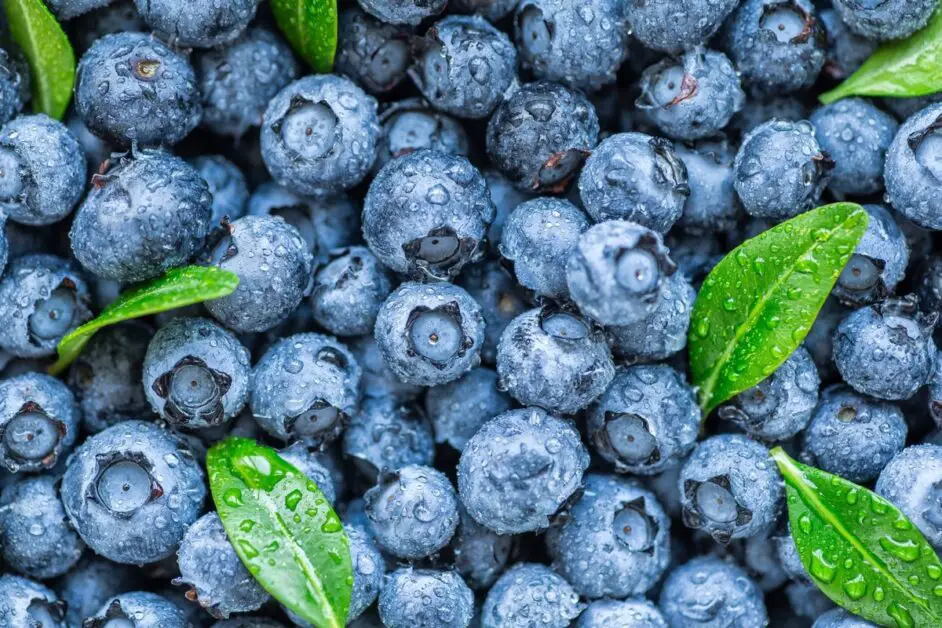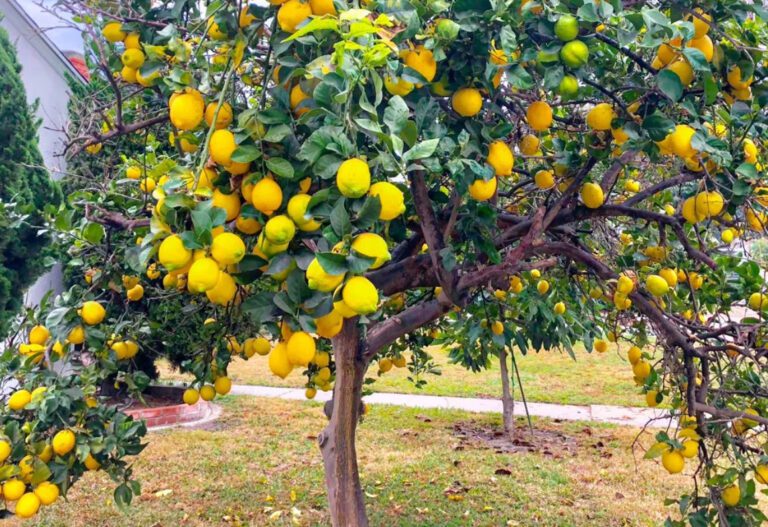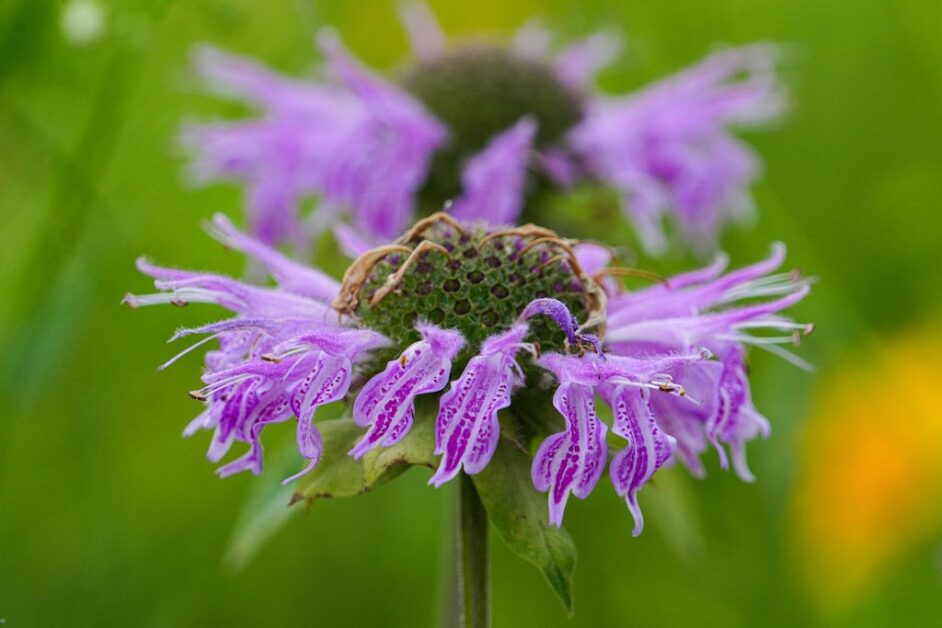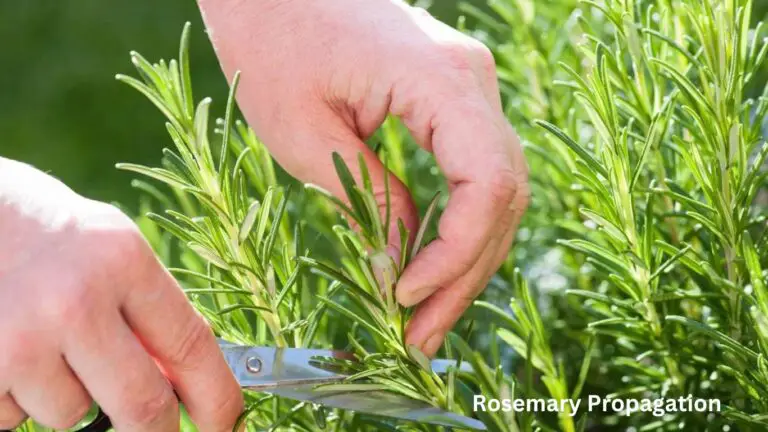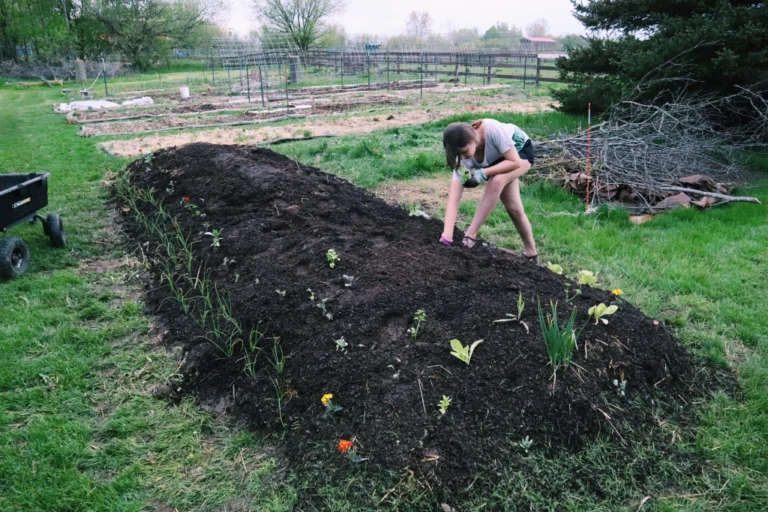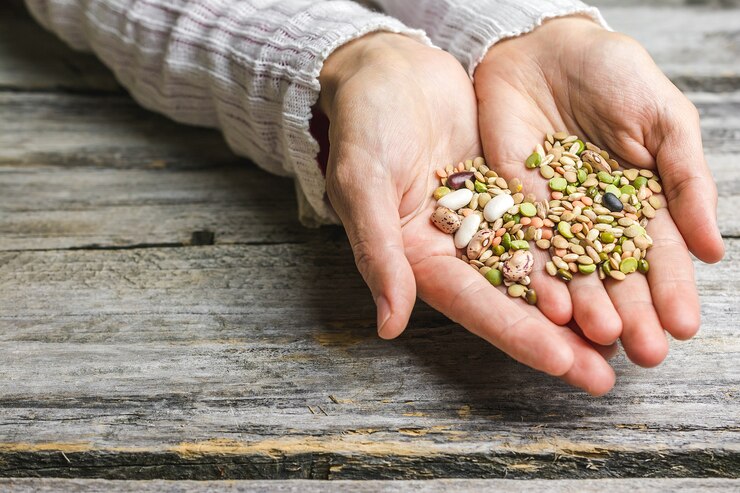Growing Blueberries: A Guide to Abundant Harvests
Are you ready to enjoy a bountiful harvest of delicious blueberries right from your own backyard? Picture this: plump, juicy berries bursting with flavor and nutrients, all grown with your own hands. Growing blueberries is not only rewarding but also surprisingly simple with the right know-how.
From selecting the perfect varieties to providing optimal care, there are key steps to ensure your blueberry bushes thrive and produce abundantly.
Join us on a journey through the world of growing blueberries as we share expert tips and tricks to help you achieve a fruitful harvest. Get ready to dive into the blueberry-growing adventure and savor the sweet rewards of your labor!
Table of Contents
Selecting the Right Blueberry Varieties for Your Region
When it comes to selecting the right blueberry varieties for your region, it’s important to consider the specific climate and environmental conditions that will support their growth. Each blueberry variety has its own unique requirements, including optimal temperature ranges, soil pH levels, and chilling hours. By understanding these factors and matching them with your region’s characteristics, you can increase your chances of a successful blueberry harvest.
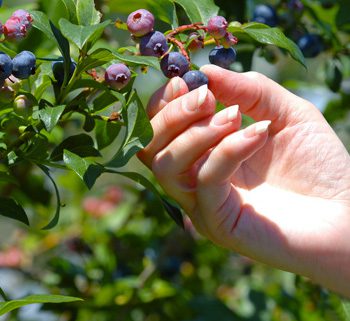
- Chilling Requirements:
- High-chill blueberry varieties like ‘Bluecrop’, ‘Jersey’, and ‘Legacy’ are suitable for cooler climates with longer winters, needing a specific number of chilling hours below 45°F (7°C) for healthy growth.
- Low-chill blueberry varieties such as ‘Sharpblue’, ‘Misty’, and ‘Sunshine Blue’ are better for regions with milder winters and fewer chilling hours.
- Climate Considerations:
- Highbush varieties like ‘Bluecrop’ and ‘Patriot’ thrive in cooler climates with temperatures between 60°F to 75°F (15°C to 24°C) during the growing season.
- Lowbush varieties such as ‘Wild Blue’ and ‘Lowbush’ are ideal for colder regions with shorter growing seasons, tolerating temperatures as low as -40°F (-40°C).
- Rabbiteye varieties like ‘Powderblue’ and ‘Brightwell’ are suited for warmer climates, enduring temperatures from 85°F to 100°F (29°C to 38°C) without damage.
- Overall Climate Suitability:
- Highbush, lowbush, and rabbiteye blueberry varieties have different temperature preferences, making it essential to match the variety with the region’s climate for optimal growth and fruit production.
By considering chilling requirements, temperature preferences, and climate suitability when selecting blueberry varieties, gardeners can ensure successful cultivation and a fruitful harvest in their specific region.
Understanding the Soil Requirements for Blueberry Plants
Blueberry plants require a specific type of soil to thrive and produce high-quality berries.
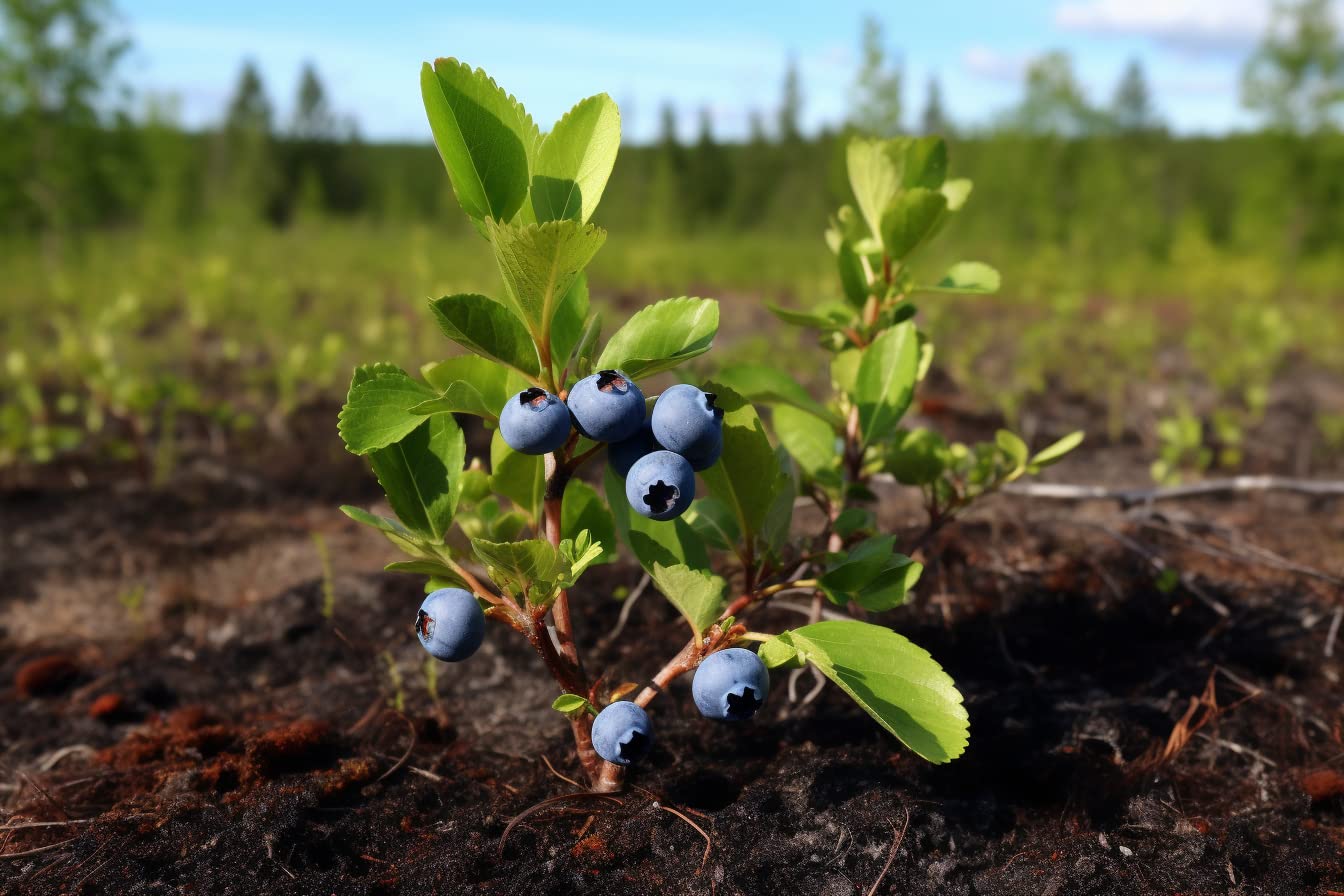
- Soil pH:
- Ideal pH: Blueberries thrive in acidic soil with a pH range of 4.5 to 5.5.
- Nutrient Uptake: Low pH ensures optimal nutrient absorption and prevents deficiencies.
- Amending Soil: Many garden soils have higher pH levels, so consider amending the soil to create the right environment for blueberries.
- Well-Draining Soil:
- Importance: Poorly drained soil can lead to root rot and diseases.
- Recommendation: Incorporate organic matter (e.g., compost or peat moss) to improve drainage.
- Healthy Roots: Proper soil texture promotes healthy root development.
Remember these points to cultivate strong and productive blueberry plants!
The following table explains about the soil requirements for blueberry plants:
| Soil Parameter | Optimal Range |
|---|---|
| 1. pH Level | 4.5 – 5.5 |
| 2. Organic Matter (%) | 3 – 5 |
| 3. Soil Texture | Sandy loam |
| 4. Moisture Level (%) | 30 – 50 |
| 5. Drainage Rate (in/hr) | 0.5 – 1.0 |
Preparing the Soil: Tips for Creating an Ideal Growing Environment
Creating an ideal growing environment for blueberry plants begins with preparing the soil. The quality and composition of the soil play a crucial role in the overall health and productivity of your blueberry bushes. Here are some tips to ensure you create the perfect soil conditions for your blueberry plants.

Blueberries thrive in acidic soil with a pH range of 4.5 to 4.8.
Measure your soil’s pH to ensure compatibility with blueberry plants’ natural requirements.
If you have naturally alkaline soil (common in the western US), it can be amended, but it requires effort. Dig deeply and widely, then add sulfur to achieve the recommended pH. Regular monitoring is necessary to maintain the proper pH level.
Blueberries need well-drained soil to thrive.
Ideal soil types include sandy loam or loamy soil.
Avoid heavy clay soils that hinder water drainage and nutrient absorption.
Incorporate organic matter into the soil to create a nutrient-rich environment.
Organic matter improves soil structure, enhances nutrient availability, and retains water.
Consider adding compost, well-rotted manure, or leaf mold.
Loosen the soil before planting by using a garden fork or tiller.
Remove weeds, perennial grasses, rocks, and other debris that could hinder blueberry growth.
Blueberry roots are shallow and dislike competition from other plants.
Remember, investing effort in soil preparation will yield delicious blueberries and a fruitful harvest! 🍇🌱
Choosing the Ideal Location for Your Blueberry Plants
Choosing the ideal location for your blueberry plants is crucial to ensure their successful growth and optimal productivity. Blueberries thrive in certain environmental conditions, and finding the right spot in your garden or orchard can contribute significantly to their overall health and yield.
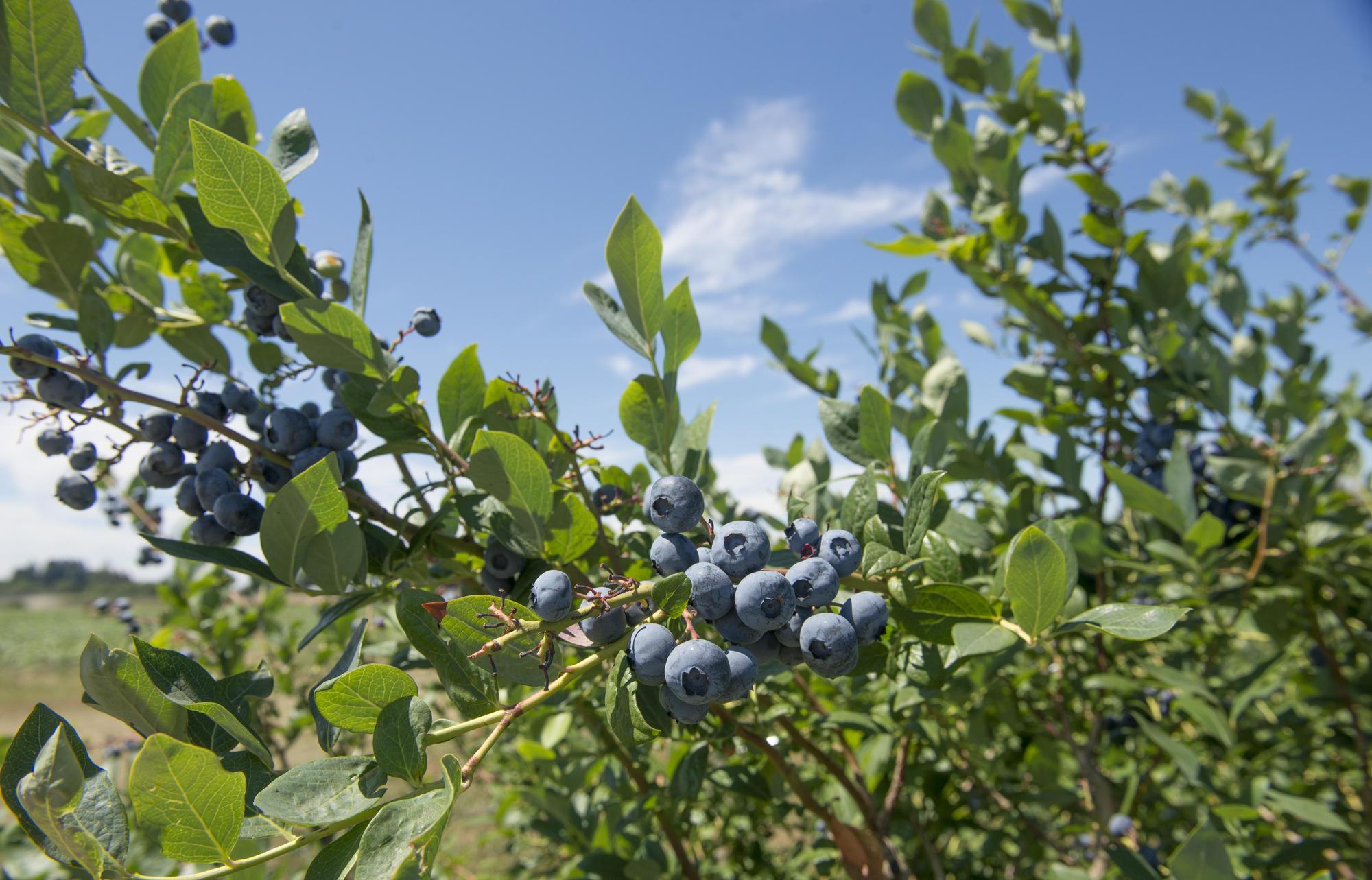
- Sunlight Exposure:
- Blueberries require full sun exposure to produce high-quality fruits.
- Aim for a minimum of 6 to 8 hours of direct sunlight per day.
- Insufficient sunlight can lead to weak growth, reduced fruit production, and increased vulnerability to pests and diseases.
- Soil Conditions:
- Acidic soil with a pH range of 4.0 to 5.0 is ideal for blueberries.
- Conduct a soil test to determine the pH level of your chosen location.
- If your soil is alkaline, consider amending it with sulfur or other soil acidifiers to lower the pH.
- Well-drained soil is crucial to prevent root rot. Incorporate organic matter like compost or peat moss to improve drainage.
- Proper Soil Preparation:
- Loosen the soil before planting to allow easy root penetration.
- Remove weeds, rocks, and debris that could hinder blueberry growth.
By following these guidelines, you’ll create an optimal environment for your blueberry plants, ensuring healthy growth and abundant harvests. 🌱
“I recently used this product and found it to be excellent. It effectively improves soil quality and retains moisture, which is crucial for healthy plant growth. Additionally, it’s easy to use and lightweight. I highly recommend it to both novice and experienced gardeners.”
- Soil Improvement: Sphagnum Peat Moss is known for its ability to enhance soil quality by adding body to thin and sandy soils, as well as aerating heavy and compacted soils. This improves soil structure, making it more conducive to plant growth.
- Moisture Retention: Peat moss has excellent moisture retention properties, helping to prevent soil from drying out too quickly. This is particularly beneficial in arid climates or for plants that require consistent moisture levels.
- Organic and Natural: Peat moss is an organic and natural material, making it an environmentally friendly choice for gardeners. It contains beneficial nutrients that can contribute to plant health and growth.
- Reduces Erosion and Fertilizer Leaching: The use of peat moss in soil helps to reduce erosion by stabilizing soil particles. Additionally, it can reduce the leaching of fertilizers, ensuring that nutrients remain available to plants for longer periods.
- OMRI Listed for Organic Gardening: The product is listed by the Organic Materials Review Institute (OMRI), indicating that it meets the standards for use in organic gardening practices. This certification provides assurance to environmentally conscious gardeners.
- Water Conservation: Peat moss aids in water conservation by reducing evaporation from the soil surface. This can lead to less frequent watering requirements and ultimately save water resources.
- Ease of Use: The compressed peat moss is easy to handle and apply, making it suitable for both novice and experienced gardeners. Its lightweight nature facilitates transportation and spreading in garden beds or pots.
- Environmental Concerns: While peat moss is a natural resource, its extraction can have negative environmental impacts, particularly on peatland ecosystems. Harvesting peat moss may contribute to habitat loss and release of carbon dioxide into the atmosphere.
- Limited Nutrient Content: While peat moss does contain some nutrients beneficial to plants, it is not a complete fertilizer. Gardeners may need to supplement with additional nutrients to meet the specific requirements of their plants.
- Acidification of Soil: Peat moss tends to be acidic, which may not be suitable for all plant species or soil types. Regular application of peat moss without pH monitoring and adjustment could lead to soil becoming too acidic over time.
- Non-renewable Resource: Peat moss is considered a non-renewable resource because it forms over thousands of years in peatlands. Overexploitation of peatlands for commercial purposes can deplete this resource faster than it can regenerate.
- Packaging Waste: The packaging of compressed peat moss, typically in plastic bags, contributes to plastic waste generation. Environmentally conscious consumers may seek alternatives with more sustainable packaging options.
- Potential for Compaction: While peat moss improves soil structure initially, over-reliance on it without incorporating other organic matter may lead to soil compaction over time, reducing aeration and water infiltration.
Planting Blueberries: Step-by-Step Instructions for Success
- Variety Selection:
- Research and choose blueberry varieties suitable for your region.
- Consider climate, soil conditions, and local weather patterns.
- Opt for varieties that thrive in your specific area.
- Soil Preparation:
- Acidic Soil: Blueberries prefer soil with a pH level between 4.5 and 5.5.
- Soil Testing: Test your soil’s pH and adjust if needed.
- Alkaline Soil: If your soil is too alkaline, incorporate organic matter like peat moss or compost to lower the pH.
- Well-Draining Soil: Improve soil structure by adding organic matter to enhance drainage.
- Healthy Roots: Properly prepared soil ensures healthy root systems for thriving blueberry plants.
Remember these points as you embark on your blueberry planting journey! 🫐🌱
Proper Watering Techniques to Ensure Healthy Blueberry Plants
When it comes to watering blueberry plants, it’s important to strike the right balance. These berries thrive in moist soil, but excessive wetness can lead to root rot and other issues. The key is to provide consistent moisture without overwatering.
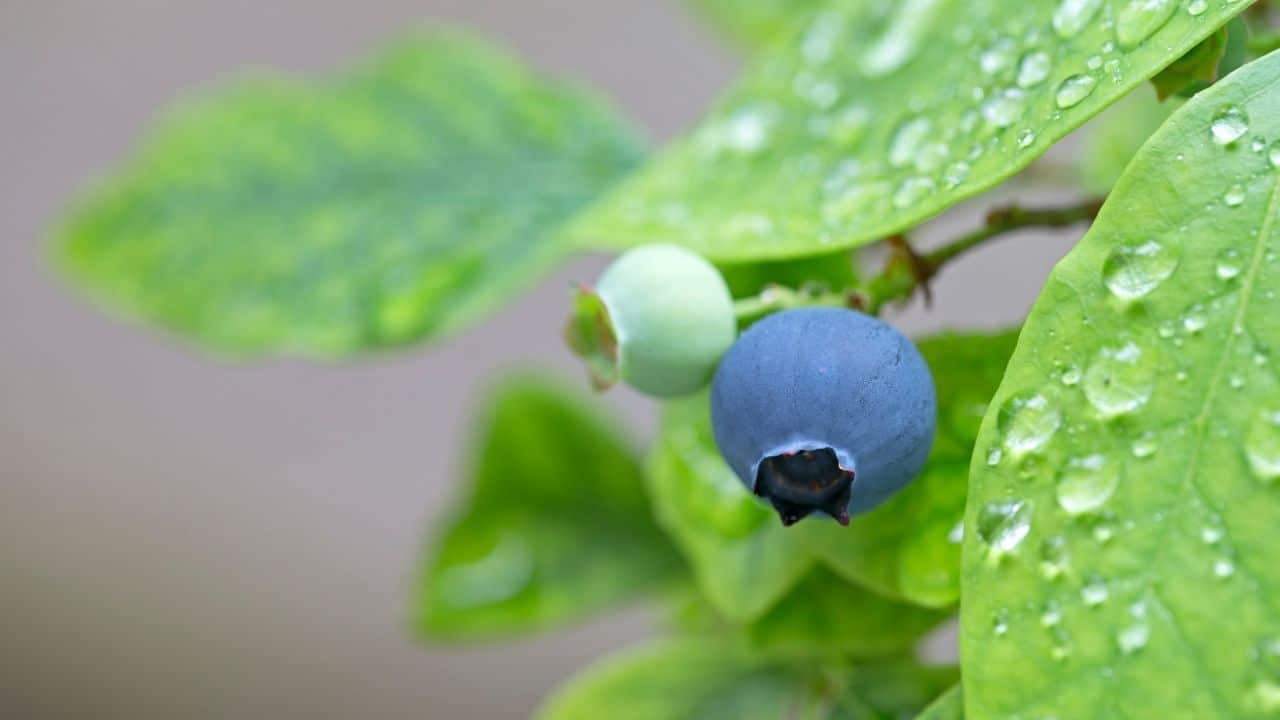
- Water Requirements:
- Blueberries need 1 to 2 inches of water per week.
- This can come from either rainfall or irrigation.
- Adjust based on local climate conditions and soil type.
- Young Plants vs. Mature Plants:
- Young blueberry plants require more frequent watering until their roots establish.
- Mature plants need less water, especially during dormancy.
- Monitoring Moisture:
- Regularly check the soil moisture.
- Insert a finger or a soil moisture meter to a depth of 4 to 6 inches.
- If the soil feels dry, it’s time to water.
Remember, consistent and appropriate watering will contribute to the success of your blueberry cultivation. Happy growing! 🌱🫐
Pruning Blueberry Bushes: Maximizing Growth and Yield
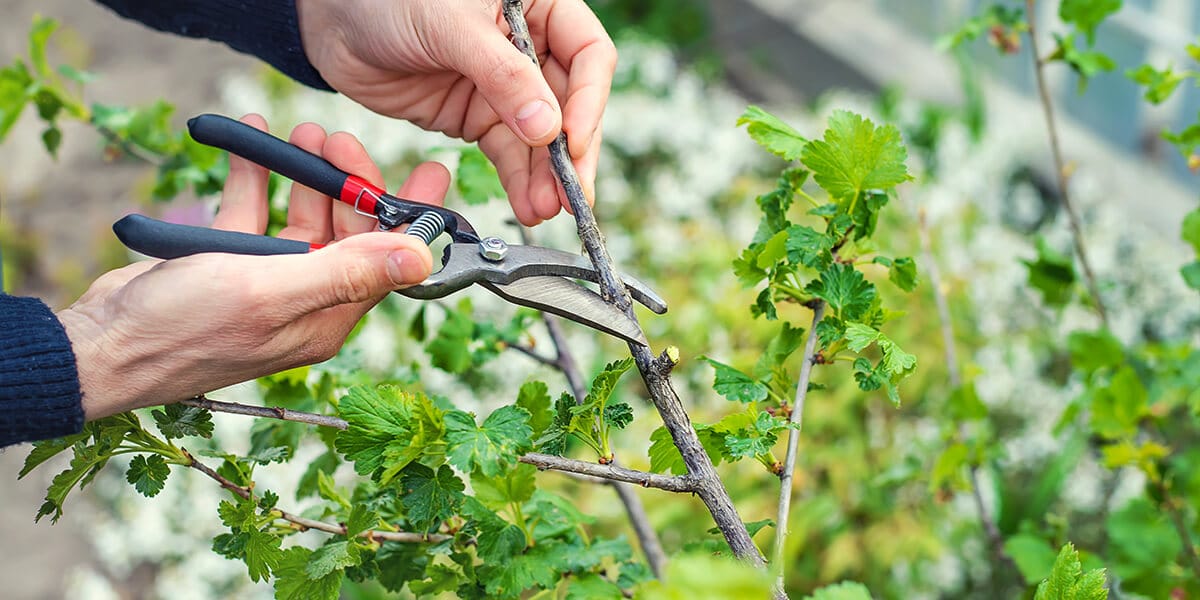
- Purpose of Pruning:
- Maximize Growth and Yield: Proper pruning promotes healthier and more productive growth.
- Remove Unwanted Branches: Eliminate dead, damaged, or diseased branches.
- Energy Allocation: Redirect the plant’s energy toward new growth and fruit production.
- Timing:
- Dormant Season: Prune during late winter or early spring.
- Benefits:
- Allows energy focus on regeneration and new shoots.
- Reduces the risk of winter injury.
- Prevents damage from diseases or pests overwintering on the plant.
By carefully selecting the branches to prune, you can ensure that the plant maintains an open structure, allowing sunlight to reach all parts of the bush, leading to better fruit development and quality. Remember to use clean, sharp pruning tools and always make clean cuts just above a bud or lateral branch to encourage proper healing.
Fertilizing Blueberries: Essential Nutrients for Optimal Harvests
Fertilizing blueberries is a critical step in ensuring optimal harvests of these delicious and nutritious berries. Blueberry plants have specific nutrient requirements that must be met in order to thrive and produce an abundance of fruit. By understanding these essential nutrients and applying them in the right quantities and at the right times, gardeners can maximize the growth and yield of their blueberry bushes.
- Soil pH: Maintain acidic soil with a pH between 4.5 and 5.1 for optimal blueberry growth.
- Balanced Fertilizer: Use organic granular fertilizer with nitrogen (N), phosphorous (P), potassium (K), and micronutrients like zinc, calcium, manganese, magnesium, and copper.
- Application Rates:
- Young plants: Apply ¼ – ½ cup per plant per year.
- Mature bushes: Apply 2 to 3 cups per bush annually.
Avoid Harmful Fertilizers:
- Steer clear of high-nitrogen, nitrate, or chloride-rich fertilizers.
- Opt for slow-release organic fertilizers to protect beneficial soil organisms.
Specialized Fertilizers:
- Choose combination fertilizers designed for acid-loving plants to maintain ideal soil conditions.
Nitrogen Sources:
- Use ammoniacal sources like ammonia sulfate or urea for established plants.
- Avoid nitrate-based fertilizers.
Monitoring and Adjustments:
- Regular soil testing and leaf tissue analysis to monitor nutrient levels.
- Adjust fertilization practices based on test results for optimal growth and harvests.
Protecting Blueberry Plants from Common Pests and Diseases
When it comes to protecting blueberry plants from common pests and diseases, taking proactive measures is key to ensuring a successful harvest.
| Pest/Disease | Symptoms | Treatment | Effective Management |
|---|---|---|---|
| Spotted Wing Drosophila | Eggs laid in ripening fruit, causing rot | Monitor with traps, inspect fruit for punctures | Use traps, inspect fruit regularly |
| Blueberry Maggot | Eggs on developing fruit, discoloration | Monitor with sticky traps, inspect for damage | Regular monitoring, use sticky traps |
| Mummy Berry | Fruit shrivels and turns brown | Inspect fruit, prune out infected canes | Inspect fruit, prune infected canes |
| Anthracnose | Leaf spots, cankers on stems | Inspect leaves, prune infected canes | Regular inspection, prune affected areas |
| Red-Leaf, Exobasidium | White patches on underside of leaves | Avoid walking through diseased areas | Prevent walking through infected areas |
| Powdery Mildew | White patches on leaves | Burn pruning to decrease infected material | Burn pruning to reduce fungal overwintering |
| Leaf Rust | Rust-colored spots on leaves | Burn pruning to decrease infected material | Burn pruning to reduce fungal overwintering |
| Stem Blight | Cankers on stems | None at this time | Cultural practices to prevent disease spread |
By following these treatments and effective management strategies, blueberry growers can protect their plants from common pests and diseases effectively.
Here are my reviews for the two products you should give a try:
- Safer Brand Houseplant Sticky Stake Insect Traps: I recently used the Safer Brand Houseplant Sticky Stakes to tackle a fungus gnat problem in my indoor plants. These stakes are designed to attract and trap various pests like fungus gnats, whiteflies, and fruit flies. The assembly was straightforward: I inserted the stakes into the soil of my potted plants, and the sticky traps did their job. However, I wish there were more sticky pads included in the pack. In the end, I had to discard the affected plant, but I believe these stakes would work well when combined with other pest control measures. Overall, they stick well and don’t dry out, making them a useful addition to my plant care routine .
- Seabright HGSLTLT Sticky Thrip Leafminer Traps: These bright yellow and blue sticky traps caught my attention. I hung them directly on my plants without causing any damage. The weatherproof traps effectively attracted and trapped flying insects like thrips, leafhoppers, and leaf miners. I’ve been using them in my garden, and they’ve significantly reduced the leafminer infestation. The traps arrived quickly, and the instructions were easy to follow. If you’re dealing with similar pests, I recommend giving these traps a try.
In summary, both products served their purpose, and I appreciate having effective pest control options for my indoor and outdoor plants. 🌿🪲
✅ Non-Toxic and Safe: The traps utilize a special formula that attracts insects without the use of harmful chemicals, making them safe for use around pets and children.
✅ Easy to Use: The traps are simple to assemble and install. Users can mount the sticks to their preferred length and insert them into potted plants easily.
✅ Discreet Design: The small size of the stakes allows them to be easily concealed by plant leaves, maintaining the aesthetic appeal of indoor plants.
✅ Reusable: Once the sticky strip is full of trapped insects, it can be easily removed, disposed of, and replaced with a fresh stick, ensuring continuous pest control.
✅ Large Quantity: The product comes with 84 stakes, providing ample coverage for multiple plants and ensuring long-term pest control.
❌ Adhesion Issues: While the majority of users praise the effectiveness of the traps’ adhesion, a few have noted that the glue can be excessively sticky, leading to accidental attachment to unintended surfaces or difficulties in removing the traps.
❌ Limited Target Species: While effective against a variety of flying insects, these traps may not target all pests equally, potentially leaving some types of pests unaffected.
❌ Frequent Replacement: Users may find themselves replacing the traps frequently, especially in heavily infested areas, which could result in ongoing costs.
❌ Environmental Impact: The disposable nature of the traps may contribute to waste generation, posing environmental concerns for some users.
✅ Can be attached directly to plants without causing damage.
✅ Attracts a broad spectrum of flying insects including aphids, whiteflies, thrips, leafhoppers, and moths.
✅ Effective in protecting plants from various pests.
✅ Easy to use and install.
✅ Comes in a pack of 5, offering good value for money.
✅ Amazon’s Choice product with high customer ratings.
❌ Few customers mentioned that the traps did not catch as many bugs as expected.
❌ Value for money might be perceived differently depending on individual experiences and expectations.
❌ Shipping and import fees to certain locations, like Pakistan, can be relatively high.
Identifying and Managing Common Blueberry Plant Issues
Blueberry plants, like any other plant, are susceptible to a variety of issues that can hinder their growth and productivity. Identifying and managing these common problems is crucial for successful blueberry cultivation. One common issue faced by blueberry growers is pest infestation. Pests such as aphids, mites, and fruit flies can significantly impact the health of blueberry plants and reduce their yield.
- Pest Infestation:
- Blueberries are susceptible to pests like aphids, mites, and fruit flies.
- Regularly inspect plants, especially the undersides of leaves and fruit clusters, to identify potential pest problems early.
- Implement natural pest control methods, such as introducing beneficial insects or using organic insecticides, to manage pests without harming the environment.
- Disease Prevention:
- Powdery mildew is a common disease in blueberries, characterized by a white powdery coating on leaves and stems.
- To prevent its spread:
- Maintain proper air circulation around the plants.
- Avoid overhead watering, as wet foliage promotes disease.
- Regular pruning removes infected parts and improves air circulation.
- Use approved fungicides as a preventive measure or to treat existing infections.
Remember these practices to ensure healthy blueberry plants and a fruitful harvest! 🌱🫐
Mulching Techniques for Blueberry Plants: Benefits and Best Practices
Mulching plays a crucial role in the successful cultivation of blueberry plants. By applying a layer of organic material around the plants, gardeners can benefit from not only improved growth and yield but also better overall plant health. One of the key benefits of mulching is its ability to conserve moisture in the soil. By acting as a barrier between the soil and the surrounding environment, mulch helps to reduce evaporation, preventing the soil from drying out too quickly.

Mulch helps retain soil moisture by reducing evaporation.
Blueberries thrive in moist, well-drained soil.
Adequate moisture promotes healthy growth and fruit production.
Mulch moderates soil temperature:
Keeps it cooler during hot weather.
Keeps it warmer in colder climates.
Stable soil temperature benefits blueberry plants.
Mulch acts as a physical barrier against weeds.
Weeds compete with blueberries for nutrients, water, and sunlight.
Suppressing weeds reduces stress on blueberry plants and improves yield.
Opt for acidic mulch types like pine needles, wood chips, or bark.
Acidic mulch helps maintain the desired pH level for blueberries.
A consistent layer of mulch acts as a natural deterrent against pests and diseases.
It provides an added layer of protection for your blueberry plants.
Remember to mulch your blueberry plants effectively to create an optimal growing environment!
Understanding the Importance of Pollination for Blueberry Harvests
Role of Bees:
- Bees are crucial for blueberry development, transferring pollen from the stamen to the stigma during bloom.
- Pollen germinates, leading to fertilized ovaries that develop into seeds, triggering berry growth.
Pollination Success:
- Adequate pollination results in a higher percent fruit set and larger berries.
- Flowers that receive sufficient pollination have more success in becoming berries.
Research Methods:
- Research tracks individual blueberry shoots from pre-bloom to harvest to assess pollination potential.
- Different treatments like open, closed, and full pollination are used to measure the effects on fruit set and berry size.
Management Strategies:
- Precision pollination practices, including coordinated pesticide applications and hive audits, improve pollination efficiency.
- Precision-pollinated plots show increased bee visits, higher fruit production, and heavier fruits compared to conventional practices.
Economic Value:
- Evaluating pollination success through metrics like fruit set, berry weight, and seed set helps determine the economic value of different pollination strategies.
- Precision management of pollination services can significantly enhance blueberry productivity and fruit quality.
Harvesting Blueberries: Indicators of Ripeness and Proper Techniques
Growing your own blueberries can be a rewarding experience, but knowing when to harvest them is crucial to ensure optimal flavor and texture. The key to harvesting blueberries lies in understanding the indicators of ripeness and employing proper techniques to handle the delicate fruit.
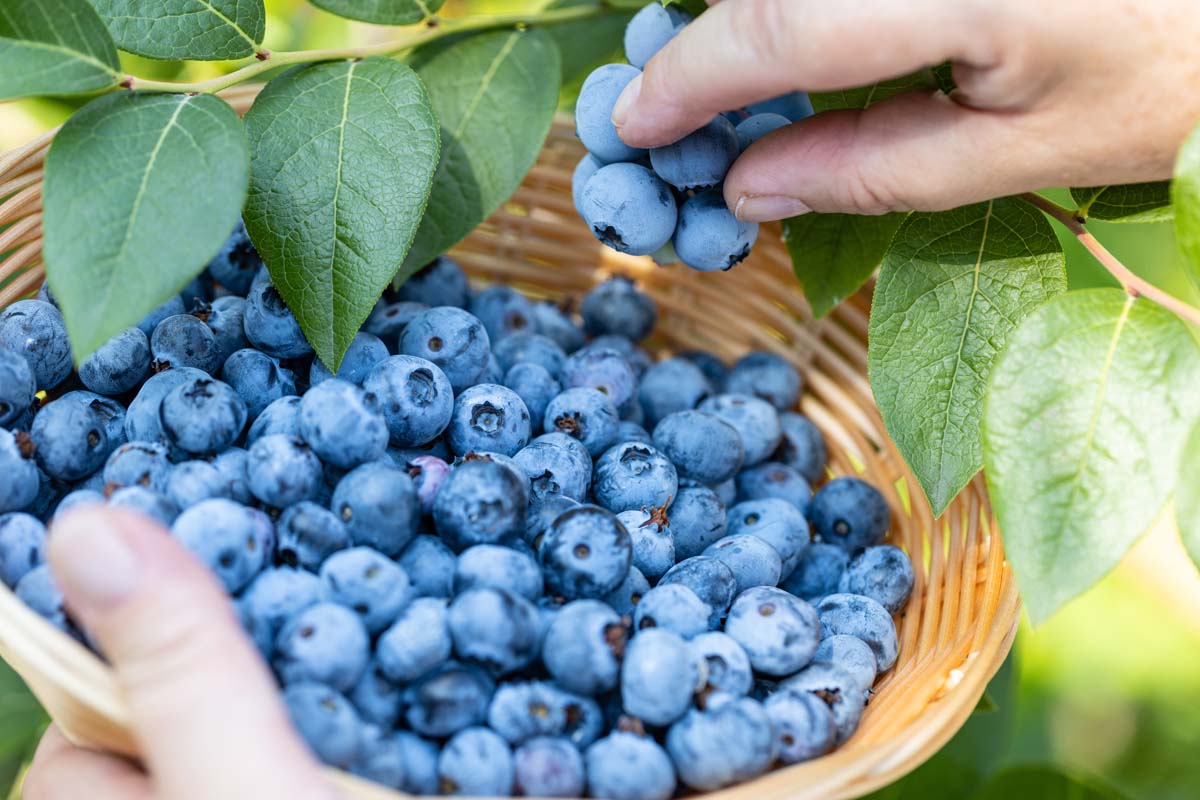
- Color Indicators:
- Blueberries transition from a greenish hue to a deep blue-purple color as they mature.
- Look for uniformly colored berries.
- Avoid picking green or red berries—they’re not fully ripe.
- Texture Check:
- Ripe blueberries should feel firm but slightly give when gently squeezed.
- They should come off the stem easily with a gentle tug.
- Avoid forceful pulling to prevent damage.
- Harvesting Technique:
- Hold the stem with one hand.
- Gently roll the berry between your thumb and index finger until it detaches.
- Handle the berries with care to prevent bruising or crushing.
- Use Clean Containers:
- Collect harvested blueberries in clean baskets or shallow trays.
- Prevent contamination of the fruit.
- Consult Local Experts:
- Timing of harvest varies by blueberry variety and climate.
- Seek advice from agricultural extension services or experienced growers in your area.
Enjoy those freshly picked blueberries at their peak of perfection! 🌱
Storing and Preserving Fresh Blueberries for Longevity
Properly storing and preserving fresh blueberries is essential to maximize their longevity and maintain their flavor and nutritional value. Whether you’ve harvested them from your own garden or purchased them from a local farmers market, following these tips will help you make the most of these delicious fruits:
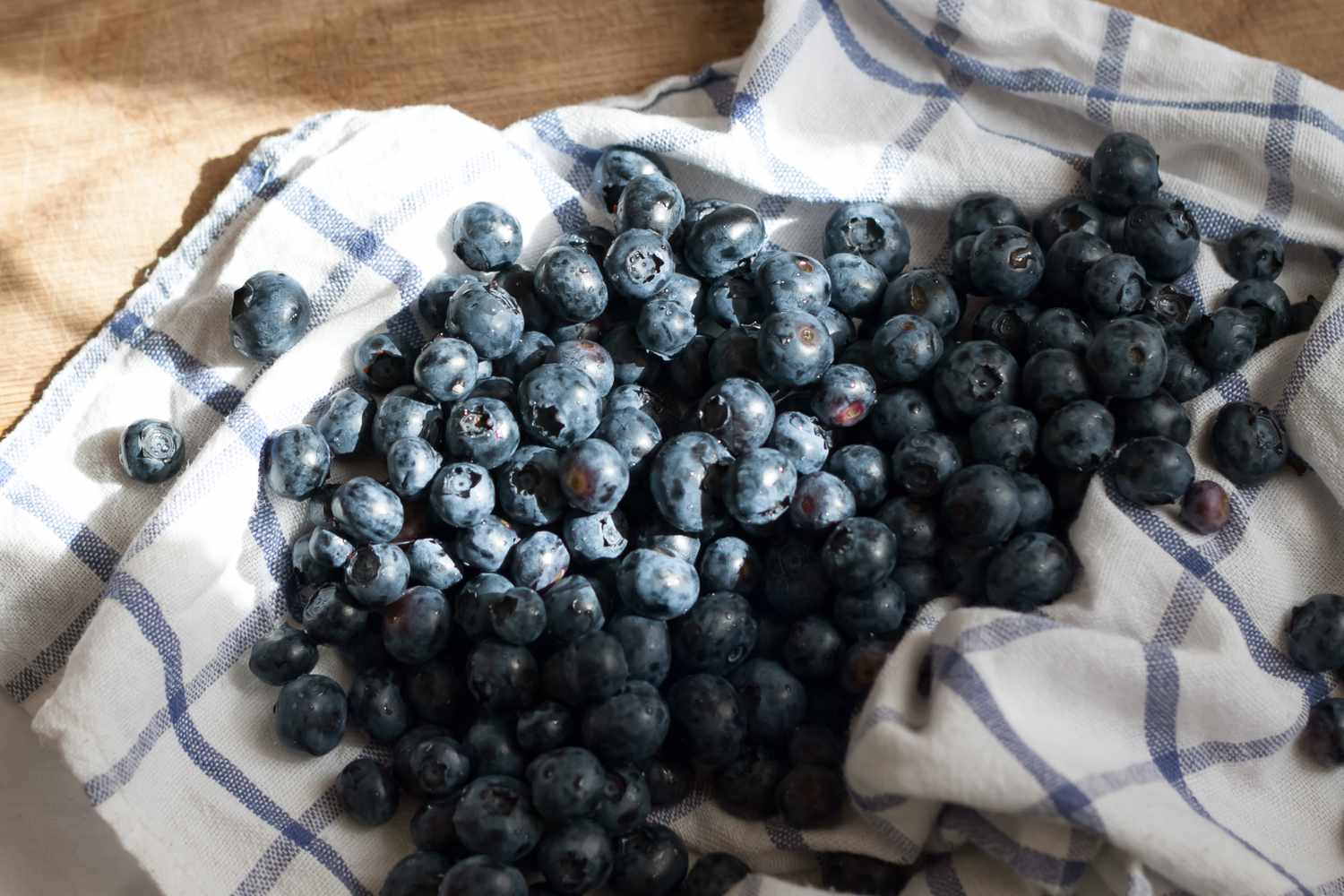
- Handle with Care:
- Gently transfer blueberries to a clean container or basket.
- Avoid crushing or bruising the delicate berries.
- Store them in a single layer to prevent excessive weight on the lower berries.
- Refrigeration:
- Refrigerate blueberries to extend their shelf life.
- Place the container in the crisper drawer:
- Slightly higher temperature.
- Optimal humidity level.
- Store unwashed blueberries with their stems intact:
- Water can accelerate spoilage.
- Rinse them just before consuming to maintain freshness.
Remember these guidelines to enjoy the delightful taste of blueberries well beyond their harvest! 🌱🫐
Propagating Blueberry Plants: Methods for Expanding Your Harvests
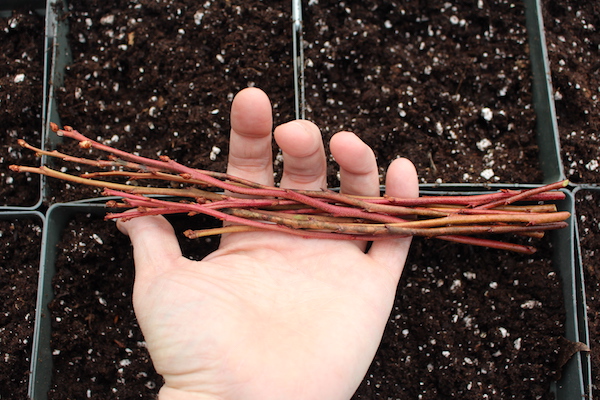
Choose a young, vigorous shoot from the current year’s growth.
Look for healthy leaves and a firm, green stem.
Use a sharp and sterilized knife or pruning shears for a clean cut.
Make a cut just below a node, where the leaves meet the stem.
The cutting should be around 4 to 6 inches long.
Remove any lower leaves to prevent excessive moisture loss.
Dip the cutting into a rooting hormone to encourage root development.
Rooting hormones are available at garden centers.
Place the cutting in a well-draining potting mix.
Use a small container or pot.
Ensure good drainage to prevent waterlogged soil.
Keep the cutting moist but not waterlogged.
Provide indirect sunlight to encourage growth.
Avoid direct sun, which can stress the cutting.
With proper care, the cutting will develop roots.
Monitor its progress over several weeks.
Once the cutting has strong roots, it can be transplanted into the garden.
Choose a suitable location with the right soil conditions.
Remember to be patient and attentive during the propagation process. Soon, you’ll have new blueberry plants ready to thrive! 🌱🫐
Troubleshooting Common Challenges in Blueberry Cultivation
Poor Fruit Production:
- Improper Pruning:
- Correct pruning techniques are essential for maximizing growth and yield.
- Prune blueberry bushes correctly to ensure healthy fruit production.
- Inadequate Pollination:
- Blueberries require cross-pollination from different varieties for effective fruit set.
- Plant compatible varieties nearby to encourage proper pollination.
- Nutrient Deficiencies:
- Essential nutrients like nitrogen, phosphorus, and potassium are crucial for fruit production.
- Conduct soil tests and provide appropriate fertilization to address nutrient deficiencies.
Pest and Disease Infestations:
- Common Pests:
- Pests like aphids, spider mites, and blueberry maggot flies can damage fruit and weaken plants.
- Implement integrated pest management strategies, including monitoring and the use of insecticides when necessary.
- Diseases:
- Diseases such as powdery mildew, mummy berry, and root rot can harm blueberry plants.
- Practice good sanitation, proper spacing, and early symptom detection to prevent disease spread.
- General Tips:
- Integrated Pest Management: Utilize cultural practices and monitor regularly.
- Sanitation: Maintain cleanliness to prevent disease spread.
- Fungicides and Disease-Resistant Cultivars: Use when necessary to mitigate disease impact.
By addressing these challenges through proper care, monitoring, and timely interventions, blueberry growers can overcome obstacles and ensure a healthy and productive harvest. Remember, local conditions may vary, so seeking advice from experts and adapting strategies to specific circumstances is crucial for successful blueberry cultivation.
Watch video for more information:
FAQ
What are the best blueberry varieties for my region?
The best blueberry varieties for your region depend on the climate and growing conditions. It is recommended to consult with local agricultural extension services or nurseries to determine the most suitable varieties for your area.
How can I prepare the soil for optimal blueberry growth?
To prepare the soil for blueberry plants, it is essential to ensure proper pH levels and organic matter content. Conduct a soil test to determine the pH and make any necessary adjustments. Adding organic matter, such as compost or peat moss, can improve soil drainage and fertility.
Where is the ideal location to plant blueberry plants?
Blueberry plants thrive in areas with full sun exposure and well-drained soil. Look for a location with good air circulation and protection from strong winds. Avoid planting in low-lying areas prone to frost or excessive water accumulation.
How do I properly water my blueberry plants?
Blueberry plants require consistent moisture, especially during fruit development. Deep watering is recommended, aiming for about 1-2 inches per week. Avoid overwatering, which can lead to root rot, and ensure the soil drains well.
When should I prune my blueberry bushes?
Pruning blueberry bushes should be done during the dormant season, preferably in late winter or early spring. Remove any dead, damaged, or diseased branches, and thin out the plant to improve air circulation and promote new growth.
What nutrients do blueberry plants need for optimal harvests?
Blueberry plants require specific nutrients such as nitrogen, phosphorus, potassium, and micronutrients like iron and manganese. Fertilize with a balanced blueberry fertilizer according to the recommended application rates, adjusting based on soil test results.
How can I protect my blueberry plants from pests and diseases?
To protect blueberry plants from common pests, such as aphids or birds, consider using netting or bird scare devices. Regularly monitor for signs of diseases like powdery mildew or mummy berry, and apply appropriate fungicides when necessary.
What are some common issues that blueberry plants face?
Blueberry plants can face issues such as nutrient deficiencies, root rot, chlorosis, or poor fruit set. Proper soil preparation, regular inspection, and maintenance practices can help prevent and address these issues.
What are the benefits of mulching blueberry plants?
Mulching blueberry plants can help retain soil moisture, control weeds, and regulate soil temperature. Organic mulches, like pine needles or wood chips, also contribute to the acidic soil conditions that blueberries prefer.
How important is pollination for blueberry harvests?
Pollination is crucial for blueberry harvests as it ensures the transfer of pollen from one flower to another, leading to fruit formation. Bees and other pollinators play a vital role in this process, so it is beneficial to provide a diverse and pollinator-friendly garden environment.
How do I know when blueberries are ripe and how should I harvest them?
Blueberries are ripe when they have reached their full color and easily detach from the plant when lightly touched. Harvest them by gently cupping the berry and twisting it off the stem. Avoid excessive force to prevent damaging the plant.
How can I store fresh blueberries for a longer shelf life?
To extend the shelf life of fresh blueberries, store them in a clean, airtight container in the refrigerator. Do not wash the berries until you are ready to consume them. Proper storage can keep blueberries fresh for up to two weeks.
How can I propagate blueberry plants to expand my harvest?
ueberry plants can be propagated through various methods such as softwood cuttings, hardwood cuttings, or layering. Consult a gardening guide or seek advice from a horticulturist for detailed instructions on each method.
What are some common challenges in blueberry cultivation?
Common challenges in blueberry cultivation include soil pH imbalances, nutrient deficiencies, pests (such as birds and aphids), diseases (like powdery mildew or root rot), and improper planting techniques. Monitoring and addressing these challenges can help ensure successful blueberry cultivation.

Studied Agricultural Engineering-Plant Protection at University of California, Davis.
Head of Content writing team at Southelmontehydroponics.com

